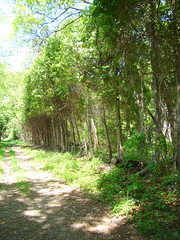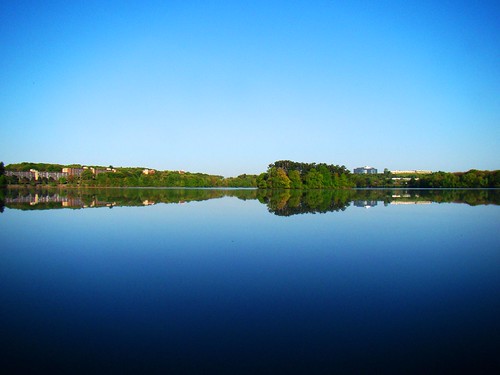Brian Keevan - DCR/DWSP Forester

Note: This is part 2 of a series about forests, reservoirs, and 'pine plantations.' Some of the information in this post came from original source documents, but many of the quotes and pictures come from the newsletter Downstream, published by the Massachusetts Department of Conservation and Recreation/ Division of Water Supply Protection. My thanks to Brian Keevan and Jim French, authors of the two excellent Downstream articles quoted in this post, and also to Edward Connors at the DCR Wachusetts Sudbury Ranger Station for answering my all questions so graciously.
QUESTION: Who planted the forests around the reservoirs and along the aqueducts in Framingham, and why where they planted?
ANSWER: We can thank the engineers of the Metropolitan Water Board for planting literally MILLIONS of trees around the reservoirs and aqueducts that provide water for the city of Boston. The brilliant and universally acclaimed Frederick P. Stearns was Chief Engineer of the Metropolitan Water Board when it was formally established in 1895. Stearns and his associates (including consulting engineer Dexter Brackett and engineer William E. Foss, both of whom would eventually hold the post of Chief Engineer) mandated the creation of a forested "buffer system" around the reservoirs to prevent erosion and sediment in the water supply.

The names Stearns, Brackett, and Foss should be very familiar to residents of Framingham. Our three reservoirs were named in honor of these men - and rightly so, as it turns out! Frederic P. Stearns was the genius who first envisioned the Wachusetts and Quabbin Reservoirs; reservoirs that still provide us with high quality water today. He was so highly regarded for his expertise that he went on to consult on the Panama Canal project! Stearns and his associates insisted that forestry was a critical component of any successful water supply system. Their mandate led to forty years of tree planting in Massachusetts. Many of the forests we know and love today began as seedlings planted by crews like the one pictured below.

The engineers who built the dams and reservoirs even specified the exact species of trees to plant, and where they should be planted! Twenty years after the Framingham reservoirs were completed, problems with the water were described by consulting engineer Mr. Dexter Brackett as making the water "subject to offensive tastes and odors, and at all times it has more or less color, which renders it somewhat objectionable for table use." One of the many problems with the Framingham reservoirs was thought to be decaying organic matter caused by leaf litter, which resulted in a policy decision to ""remove all deciduous trees which are so near the reservoir that leaves would fall therein, or to provide a screen of arbor vitae or similar evergreens." (Waterworks Handbook, 1916) This explains the previously inexplicable rows of Eastern Red Cedar and Arborvitae trees I saw around the Foss and Sudbury reservoirs! They aren't just "ornamentals" after all!


"About 28 acres of Sudbury Reservoir marginal lands were cleared of small trees and brush and 49,300 three-year-old white pine seedlings, 43,700 three-year-old Scotch pines, 44,050 three-year-old red pines and 43,500 four-year-old white spruces were planted from the nursery. Fifteen hundred three-year-old white pines were set out west of Edgell Street, Nobscot, and 13,100 four year old seedlings at Framingham Reservoir No 3. Along the Weston Aqueduct 6,950 four year old seedlings, and along the Sudbury and Cochituate aqueducts 11,500 seedlings have been planted during the year." (Massachusetts Metropolitan Water and Sewerage Board Annual Report 1917 William E. Foss, Chief Engineer)

The Metropolitan Water and Sewerage Board Annual Reports indicate that trees were planted along the Weston, Sudbury, Cochituate, and Hultman aqueducts every year. Preventing erosion and keeping roots away from underground structures are both mentioned in various documents as reasons for the aqueduct trees. If you dig hard enough, though, you'll see that there was also a financial motive behind those "Pine Plantations"!

You won't find it mentioned in the official MWRA History, but get this quote from the first official Massachusetts State Forester: "There has been of late much discussion on the subject of forests and their relation to stream flow, and we could, if we chose, give you a sermon on this subject, but we have elected in this article to present to you the financial side of the question; in other words, the money profit which towns may obtain from lands which are now in their possession lying idle and unused."(1911) Forester F.W. Rane goes on to detail the exact dollar amount each town could expect to reap from planting and judiciously thinning Red and White Pines on municipal lands! "Municipal forests about the drainage basins of our water supplies and reservoirs can be made not only an important factor in conserving the water supply and in improving sanitary conditions, but, if put under a modern system of forestry management, could be made a great economic factor in the production of wood and lumber."

Just as we suspected, right? What isn't funny, however, is the sorry state of those abandoned tree plantations now. Forestry involves a lot more than just planting trees; there is a complicated and very long term process that must be followed to create a healthy and sustainable forest. The stands of pure pine trees along the Hultman and all over the reservoirs lands have not been properly maintained. Because the stands were never thinned, a healthy mix of new trees never got a chance to grow. The trees are overcrowded, top-heavy, and decidedly unhealthy. Instead of a healthy and diverse mix of tree species and vegetation (i.e., a forest!), we have an accident waiting to happen!

"Single species (monoculture) tree plantations have proven particularly problematic to manage as they age, due to their susceptibility to storm and disease risks. They do not respond well to thinning and do not support diverse wildlife populations. In addition, many of the plantations were “mismatched” to their site. Each tree species has a preferred type of soil and moisture regime. This was not well understood when these trees were being blanketed over the land irrespective of soil conditions. "
Jim French - DCR/DWSP Land Acquisitions Coordinator

We have no one to blame but ourselves. The last time DCR tried to thin a stand of trees around here, local "tree-huggers" objected so dramatically that the operation was abandoned. If you know anyone who thinks they're being "green" by saving a tree, please set them straight! They are not only showing their ignorance - they are throwing away one hundred years of forestry planning and effort! We could end up bereft of trees once again!

Isn't it beautiful? I think it is!
I'll wrap this up with another quote from Jim French at DCR (I couldn't write a better ending for this story if I spent all night trying!):
"The first century forestry focus was to establish a forest. The second will be to manage that forest to best achieve benefits and amenities that a natural indigenous landscape of trees provides for the reservoir watersheds."
Jim French DCR/DWSP Land Acquisitions Coordinator

Susan:
ReplyDeletei didn't quite understand the money aspect of it. how would the town make money by planting trees? wasn't the land already town property?
The intention was to harvest the wood after 40 to 50 years, and sell it. Pines are fast growing and without competition they grow very straight and knot free. Pine is a very desirable wood to this day. Red pines make perfect telephone poles, for instance.
ReplyDeleteI throughly enjoyed this post.
ReplyDeleteThanks, Andy. I enjoyed writing it!
ReplyDelete